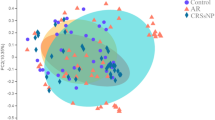Abstract
The role of fungi in chronic rhinosinusitis (CRS) remains unknown. Fungi were also determined as one of the responsible agents in the etio-pathogenesis, while several studies found fungi in 6–93% of the cases. The aim of this study is to test the presence of fungi in samples taken from the middle meatus of patients with CRS, using traditional culture methods and polymerase chain reaction (PCR), and to compare the efficacy of these methods. Thirty patients diagnosed with CRS, with or without nasal polyposis, undergoing an operation in the Otorhinolaryngology Clinic, were prospectively included in the study. Nasal mucosa samples from ten patients, who were operated for pathologic evaluation, and without CRS, were used as controls. Nasal samples were taken from each patient by swabbing with a cytology brush. Middle meatus culture samples were taken by using nasal cotton swab, and the polyp and/or sinus mucosa samples were taken during endoscopic sinus surgery. Fungal specific PCR, using 18S rRNA primers and standard cultures, were performed on every sample. All amplicons were sequenced. There was no fungal growth in the Sabouraud dextrose agar (SDA) medium from middle meatus samples and tissue parts. Of 30 tissue and brush samples, 3 and 2 were positive for fungal DNA, respectively. Sequence analysis showed that four amplicons were homologus to Cladosporium herbarum and one to Aspergillus amstelodami. We concluded that fungal etiology is overestimated and fungi rarely play a role in patients with CRS. Large-scale studies should be done using molecular methods.

Similar content being viewed by others
References
Bent JP, Kuhn FA (1994) Diagnosis of allergic fungal sinusitis. Otolaryngol Head Neck Surg 111:580–588
Braun H, Buzina W, Freudenschuss K, Beham A, Stammberger H (2003) Eosinophilic fungal rhinosinusitis: a common disorder in Europe? Laryngoscope 113:264–269
Catten MD, Murr AH, Goldstein JA, Mhatre AN, Lalwani AK (2001) Detection of fungi in the nasal mucosa using polmerase chain reaction. Laryngoscope 111:399–403
Dosa E, Doczi I, Mojzes L, Molnar EG, Varga J, Nagy E (2002) Identification and indicence of fungal strains in chronic rhinosinusitis patients. Acta Microbiol Immunol Hung 49(2–3):337–346
Gillespie MB, Huchton DM, O’Malley BW (2000) Role of midlle turbinate biopsy in the diagnosis of fulminant invasive fungal rhinosinusitis. Laryngoscope 110:1832–1836
Gold SM, Tami TA (1997) Role of middle meatus aspiration culture in the diagnosis of chronic sinusitis. Laryngoscope 107:1586–1589
Gosepath J, Brieger J, Vlachtsis K, Mann WJ (2004) Fungal DNA is present in tissue specimens of patients with chronic rhinosinusitis. Am J Rhinol 18(1):9–13
Karpovich-Tate N, Dewey FM, Smith EJ, Lund VJ, Gurr PA, Gurr SJ (2000) Detection of fungi in sinus fluid of patients with allergic fungal rhinosinusitis. Acta Otolaryngol 120(2):296–302
Kumar M, Shukla PK (2005) Use of PCR targeting of internal transcribed spacer regions and single-stranded conformation polymorphism analysis of sequence variation in different regions of r RNA genes in fungi for rapid diagnosis of mycotic keratitis. J Clin Microbiol 43(2):662–668
Lebowitz RA, Waltzman MN, Jacobs JB, Pearlman A, Tierno PM (2002) Isolation of fungi by standard laboratory methods in patients with chronic rhinosinusitis. Laryngoscope 111:2189–2191
Marple BF (2001) Allergic fungal rhinosinusitis: current theories and management strategies. Laryngoscope 111:1006–1019
Park AH, Muntz HR, Smith ME, Afify Z, Pysher T, Pavia A (2005) Pediatric invasive fungal rhinosinusitis immunocompromised children with cancer. Otolaryngol Head Neck Surg 133:411–416
Petti CA (2007) Detection and identification of microorganisms by gene amplification and sequencing. Clin Infect Dis 44:1108–1114
Ponikau JU, Sherris DA, Kern EB (1999) The diagnosis and incidence of allergic fungal sinusitis. Mayo Clin Proc 74:877–884
Rao AK, Mathers PH, Ramadan HH (2006) Detection of fungi in the sinus mucosa using polymerase chain reaction. Otolaryngol Head Neck Surg 134:581–585
Schuller MC, Murr AH, Goldberg AN, Mhatre AN, Lalwani AK (2004) Quantitative analysis of fungal DNA in chronic rhinosinusitis. Laryngoscope 114:467–471
Weschta M, Rimek D, Formanek M, Polzehl D, Riechelmann H (2003) Local production of Aspergillus fumigatus specific immunoglobulin E in nasal polyps. Laryngoscope 113:1798–1802
Zhou G, Whong WZ, Ong T, Chen B (2000) Development of a fungus-specific PCR assay for detecting low-level fungi in an outdoor environment. Mol Cell Probes 14:339–348
Author information
Authors and Affiliations
Corresponding author
Rights and permissions
About this article
Cite this article
Eyigor, H., Eyigor, M., Gunel, C. et al. Characterization of fungi in chronic rhinosinusitis using polymerase chain reaction and sequencing. Eur Arch Otorhinolaryngol 265, 651–655 (2008). https://doi.org/10.1007/s00405-007-0529-0
Received:
Accepted:
Published:
Issue Date:
DOI: https://doi.org/10.1007/s00405-007-0529-0




